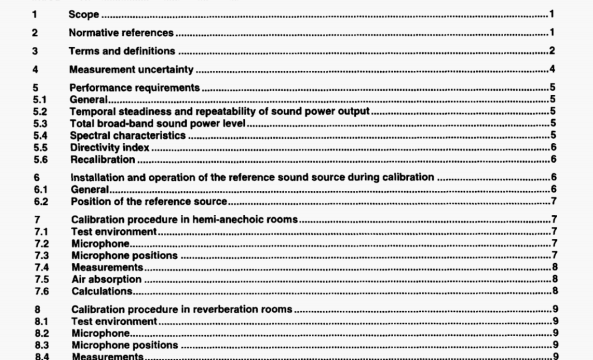ISO 6926 pdf download – Acoustics-Requirements for the performance and calibration of reference sound sources used for the determination of sound power levels.
5.5 Directivity Index
The highest value of the directivity index of the source in any one-third-octave band with midband frequency between 100 Hz and 10000 Hz, shall not exceed +6 dB when measured in a hemi-anechoc room complying with dause 7. It a moving microphone is used, the maximum sound pressure level, measured with time-weighting S. for each one-third-octave band during any traverse shall be recorded and used to compute the directivity index. For fixed microphone positions, the maximum sound pressure level for each frequency band of any of the 20 positions shall be used.
It the RSS is to be used exclusively in reverberation rooms complying with ISO 3741, the above requirements do not apply but in that case the RSS shall be labelled “For use as a reference sound source in qualified reverberation rooms only’.
lithe ASS is designed to be used on a stand above the floor, the above requirements apply for a free field and the directivity measurements are to be carried out in an anechoic room according to ISO 3745.
5.6 Recalibratlon
The manufacturer shall recommend the maximum time interval between successive calibrations. During this interval, changes in the sound power levels of the reference sound source shall not exceed the limits given in Table 2. Whenever any mechanical damage has been inflicted on the reference sound source, it shall be recalibrated.
In order to determine whether or not recalibration of a relerence sound source is necessary during the recommended maximum time mterval, one-third-octave-band Sound pressure levels should be measured occasionally at one or more fixed reference points (e.g. at time intervals and locations recommended by the manufacturer) with the source operating at a specitic location in a specified test environment. If, after using manufacturer-specified procedures to adjust the measured sound pressure levels to constant environmental conditions when necessary, changes in any one-third-octave-band sound pressure level exceed 2,83 times the values in Table 2, recalibration of the reference sound source may be necessary (see ISO 5725-1).
6 Installation and operation of the reference sound source during calibration
6.1 General
The source shall be operated W accordance with the manufacturer’s instructions. The essential charactenstics of the source of mechanical or electrical power (e.g. line voltage and frequency) and the relevant operating parameters of the reference sound source (e.g. rotational speed of an aerodynamic source) shall be recorded.
NOTE It may be necessary to use auxiliary equipment to measure the relevant operating parameters (e.g. a stroboscope to determine rotational speed).
The reference Sound source shall be in a stable operating condition before any measurements (either of acoustic properties or of operating parameters) are made.
7 Calibration procedure in hemi-anecholc rooms
7.1 Test environment
The test environment shall be a hemi-anechoic room meeting the qualification requirements of annex A of ISO 3745:1977 over the frequency range of interest. The floor shall extend at least 1 m in each horizontal direction beyond the projection of the measurement surface onto the floor.
7.2 Microphone
For the normal frequency range of interest, use either a microphone with a nominally flat frequency response at normal incidence mounted with the plane of the diaphragm towards the centre of the measurement hemisphere or a microphone with a nominally flat frequency response at grazing incidence mounted with the plane of the diaphragm at 9Q0 towards the centre of the measurement hemisphere. The microphone response shall be corrected to give a flat frequency response within 0,1 dB at normal incidence or grazing incidence over the frequency range of interest. If the frequency range is extended above the 10 000 Hz one-third-octave band, use only a microphone with a nominally flat frequency response at grazing incidence.
7.3 Microphone positions
7.3.1 General
Use a hemispherical measurement surface with a radius of 2 m. Centre it over the geometrical centre of the projection of the top surface of the RSS on the reflecting plane. Use one of the sets of microphone positions given in 7.3.2, 7.3.3. 7.3.4 or 7.3.5. Make sure that the mechanical arrangement for fixing or moving the microphone does not affect the measurements.
ISO 6926 pdf download – Acoustics-Requirements for the performance and calibration of reference sound sources used for the determination of sound power levels
